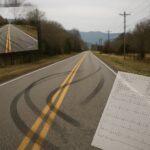You crest a hill and meet a wall of wind from a passing semi. Your car shudders. Up ahead, brake lights ripple through traffic. Moments like this are routine in Tennessee, but small choices matter. Semis are heavier, take longer to stop, and have large blind spots. Understanding how they move helps you reduce risk.
- Most victims in fatal large‑truck crashes are people in other vehicles. In 2021, 72% of people killed in crashes involving large trucks were occupants of other vehicles (NHTSA, 2021 Large Trucks Traffic Safety Facts).
- Trucks need more distance to stop. At 55 mph in ideal conditions, a loaded tractor‑trailer needs about 196 feet to brake vs. 133 feet for a passenger car (FMCSA, Following Too Closely). Wet or downhill conditions increase distance.
- Blind spots are real and big. FMCSA’s No‑Zone materials show sizable blind spots along the right side, directly behind, and a smaller one in front of the cab (FMCSA, Tips for Passenger Vehicle Drivers). See the official blind‑spot diagram and stopping distance infographic: FMCSA PDF Infographic.
Tip 1: Stay out of blind spots
Why it matters: Blind spots, or No‑Zones, sit along both sides of a truck (especially the right), directly behind the trailer, and just in front of the cab. If you can’t see the driver’s face in the mirror, they likely can’t see you.
Do this:
- Pass on the left when possible. Move through the blind spot promptly.
- Don’t follow close behind a trailer where you disappear from view.
- If you’re stuck beside a truck, drop back or speed up safely to get clear.
Tip 2: Give extra room in bad weather or poor visibility
Why it matters: Heavy vehicles need longer to stop. FMCSA notes a loaded tractor‑trailer at 55 mph needs ~196 feet in ideal conditions. Rain, ice, debris, and road surface conditions increase this distance. Speed increases stopping distance for everyone. NHTSA training materials show how a small speed increase can dramatically raise stopping distance (e.g., 60 mph vs. 50 mph).
Do this:
- In rain or fog, add more following distance.
- Avoid merging in front of a semi unless you can keep a steady speed and see daylight between you and their bumper.
- Use smooth, early braking so the truck behind you has time to react.
Tip 3: Be careful on hills, downgrades, and curves
Why it matters: Long downgrades heat brakes. Curves increase rollover risk. Tennessee’s interstates include steep grades where heavy trucks work hard to manage speed. FMCSA crash tables also show weather and roadway environment factors in many large‑truck crashes (FMCSA, LTBCF 2021).
Do this:
- Avoid sitting directly in front of a truck on a downhill stretch.
- Leave space and expect slower speeds on long climbs.
- Don’t pass unless sightlines are clear and you can complete the pass safely.
Tip 4: Signal early and drive predictably
Why it matters: Trucks are longer and respond more slowly to sudden lane changes or last‑second braking. Predictable driving reduces conflicts. FMCSA’s guidance for passenger vehicles stresses early signaling and avoiding erratic moves around large trucks (FMCSA, Tips for Passenger Vehicle Drivers).
Do this:
- Signal well in advance. Hold a steady pace.
- Avoid weaving or squeezing into tight gaps near semis.
- Keep your lane changes slow and deliberate so truck drivers can plan.
Tip 5: Be patient with turns and wide maneuvers
Why it matters: Trucks make wide right turns and sometimes use more than one lane to complete a maneuver. Cutting inside that turn can lead to a squeeze or underride scenario. FMCSA training materials highlight wide turns and underride risks.
Do this:
- When a semi is turning, wait. Don’t try to slip by on the right.
- Give space at intersections and driveways so trailers can clear the corner.
- Watch for swing as the trailer tracks inside the cab’s path.
Following Distance Calculator
Use the below calculator to estimate a safe following distance in feet based on a simple time‑gap rule of thumb. This is not a substitute for judgment. Increase the time gap for heavy traffic, bad weather, or poor visibility.
Conclusion
Sharing the road with semis boils down to visibility, space, and predictability. Stay out of blind spots, give extra room in poor conditions, respect hills and curves, signal early, and be patient with wide turns.
If you’ve been injured in a crash, Stillman & Friedland is here to help. Call 615‑244‑2111 or reach out through our online contact form.
Because we care,
Stillman & Friedland







